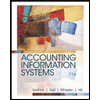
Managerial Accounting
15th Edition
ISBN: 9780078025631
Author: Ray H Garrison, Eric Noreen, Peter C. Brewer Professor
Publisher: McGraw-Hill Education
expand_more
expand_more
format_list_bulleted
Textbook Question
Chapter 4.B, Problem 4E
EXERCISE 4B-4 Direct Method LO4-10
Refer to the data for the Ferre Publishing Company in Exercise 4B-3.
Required:
Assuming that the company uses the direct method rather than the step-down method to allocate service department costs, how much cost would be assigned to each operating department?
Expert Solution & Answer
Want to see the full answer?
Check out a sample textbook solution
Students have asked these similar questions
Summit Mechanical Co. has a normal capacity of 25,000 direct labor hours. The company's variable costs are $32,500, and its fixed costs are $18,750 when operating at normal capacity. What is its standard manufacturing overhead rate per unit?
hello teacher please solve questions
Opereting leverage?
Chapter 4 Solutions
Managerial Accounting
Ch. 4.A - EXERCISE 4A-1 Computation of Equivalent Units of...Ch. 4.A - EXERCISE 4A-2 Cost per Equivalent Unit-FIFO Method...Ch. 4.A - EXERCISE 4A-3 Assigning Costs to Units-FIFO Method...Ch. 4.A - EXERCISE 4A-4 Cost Reconciliation Report-EIFO...Ch. 4.A - EXERCISE 4A-5 Computation of Equivalent Units of...Ch. 4.A - EXERCISE 4A-6 Equivalent Units of Production-FIFO...Ch. 4.A - EXERCISE 4A-7 Equivalent Units of Production and...Ch. 4.A -
EXERCISE 4A-8 Equivalent Units of Production—FIFO...Ch. 4.A - EXERCISE 4A-9 Equivalent Units; Equivalent Units...Ch. 4.A - PROBLEM 4A-10 Equivalent Units of Production;...
Ch. 4.A - Prob. 11PCh. 4.A - Prob. 12CCh. 4.B - Prob. 1ECh. 4.B - EXERCISE 4B-2 Step-Down Method LO4-11 Madison Park...Ch. 4.B - Prob. 3ECh. 4.B - EXERCISE 4B-4 Direct Method LO4-10 Refer to the...Ch. 4.B - Prob. 5PCh. 4.B - PROBLEM 4B-6 Step-Down Method versus Direct...Ch. 4.B - CASE 4B-7 Step-Down Method versus Direct Method...Ch. 4 - Prob. 1QCh. 4 - In what ways are job-order and process costing...Ch. 4 - Why is cost accumulation simpler in a process...Ch. 4 - How many Work in Process accounts are maintained...Ch. 4 - Prob. 5QCh. 4 - Prob. 6QCh. 4 - Prob. 7QCh. 4 - Prob. 8QCh. 4 - Prob. 1AECh. 4 - This exercise relates to the Double Diamond Skis’...Ch. 4 - This exercise relates to the Double Diamond Skis’...Ch. 4 - Clopack Company manufactures one product that goes...Ch. 4 - Clopack Company manufactures one product that goes...Ch. 4 - Clopack Company manufactures one product that goes...Ch. 4 - Clopack Company manufactures one product that goes...Ch. 4 - Clopack Company manufactures one product that goes...Ch. 4 -
Clopack Company manufactures one product that...Ch. 4 -
Clopack Company manufactures one product that...Ch. 4 -
Clopack Company manufactures one product that...Ch. 4 - Clopack Company manufactures one product that goes...Ch. 4 - Prob. 10F15Ch. 4 - Prob. 11F15Ch. 4 - Prob. 12F15Ch. 4 -
Clopack Company manufactures one product that...Ch. 4 - Prob. 14F15Ch. 4 - Prob. 15F15Ch. 4 - Prob. 1ECh. 4 - EXERCISE 4-2 Computation of Equivalent...Ch. 4 - Prob. 3ECh. 4 - EXERCISE 4-4 Assigning Costs to...Ch. 4 - EXERCISE 4-5 Cost Reconciliation...Ch. 4 - Prob. 6ECh. 4 - Prob. 7ECh. 4 - Prob. 8ECh. 4 -
EXERCISE 4-9 Equivalent Units and Cost per...Ch. 4 - Prob. 10ECh. 4 - Prob. 11ECh. 4 - Prob. 12ECh. 4 - Prob. 13PCh. 4 - Prob. 14PCh. 4 - Prob. 15PCh. 4 - PROBLEM 4-16 Comprehensive...Ch. 4 - Prob. 17PCh. 4 - Prob. 18PCh. 4 - Prob. 19CCh. 4 - (
CASE 4-20 Ethics and the Manager, Understanding...
Knowledge Booster
Learn more about
Need a deep-dive on the concept behind this application? Look no further. Learn more about this topic, accounting and related others by exploring similar questions and additional content below.Similar questions
- Suppose Loc Motors, Inc. has 720 million shares outstanding with a share price of $65.20, and $30.85 billion in debt. If in three years, Loc Motors has 770 million shares outstanding trading for $78.45 per share, how much debt will Loc Motors have if it maintains a constant debt-equity ratio? The amount of debt required in three years will be $_ billion. Accounting problemarrow_forwardGeneral Accountingarrow_forwardWhat was the net income for the year?arrow_forward
- Suppose Loc Motors, Inc. has 720 million shares outstanding with a share price of $65.20, and $30.85 billion in debt. If in three years, Loc Motors has 770 million shares outstanding trading for $78.45 per share, how much debt will Loc Motors have if it maintains a constant debt-equity ratio? The amount of debt required in three years will be $_ billion.arrow_forward!??arrow_forwardhi expert please help me general accountarrow_forward
- Suppose Loc Motors, Inc. has 720 million shares outstanding with a share price of $65.20, and $30.85 billion in debt. If in three years, Loc Motors has 770 million shares outstanding trading for $78.45 per share, how much debt will Loc Motors have if it maintains a constant debt-equity ratio? The amount of debt required in three years will be $_ billion. Need answerarrow_forwardPlease give me answer general accounting questionarrow_forwardFinancial Accounting Question need help pleasearrow_forward
arrow_back_ios
SEE MORE QUESTIONS
arrow_forward_ios
Recommended textbooks for you
 Accounting (Text Only)AccountingISBN:9781285743615Author:Carl Warren, James M. Reeve, Jonathan DuchacPublisher:Cengage Learning
Accounting (Text Only)AccountingISBN:9781285743615Author:Carl Warren, James M. Reeve, Jonathan DuchacPublisher:Cengage Learning Accounting Information SystemsFinanceISBN:9781337552127Author:Ulric J. Gelinas, Richard B. Dull, Patrick Wheeler, Mary Callahan HillPublisher:Cengage Learning
Accounting Information SystemsFinanceISBN:9781337552127Author:Ulric J. Gelinas, Richard B. Dull, Patrick Wheeler, Mary Callahan HillPublisher:Cengage Learning Managerial Accounting: The Cornerstone of Busines...AccountingISBN:9781337115773Author:Maryanne M. Mowen, Don R. Hansen, Dan L. HeitgerPublisher:Cengage Learning
Managerial Accounting: The Cornerstone of Busines...AccountingISBN:9781337115773Author:Maryanne M. Mowen, Don R. Hansen, Dan L. HeitgerPublisher:Cengage Learning Financial & Managerial AccountingAccountingISBN:9781337119207Author:Carl Warren, James M. Reeve, Jonathan DuchacPublisher:Cengage Learning
Financial & Managerial AccountingAccountingISBN:9781337119207Author:Carl Warren, James M. Reeve, Jonathan DuchacPublisher:Cengage Learning Financial & Managerial AccountingAccountingISBN:9781285866307Author:Carl Warren, James M. Reeve, Jonathan DuchacPublisher:Cengage Learning
Financial & Managerial AccountingAccountingISBN:9781285866307Author:Carl Warren, James M. Reeve, Jonathan DuchacPublisher:Cengage Learning Cornerstones of Cost Management (Cornerstones Ser...AccountingISBN:9781305970663Author:Don R. Hansen, Maryanne M. MowenPublisher:Cengage Learning
Cornerstones of Cost Management (Cornerstones Ser...AccountingISBN:9781305970663Author:Don R. Hansen, Maryanne M. MowenPublisher:Cengage Learning

Accounting (Text Only)
Accounting
ISBN:9781285743615
Author:Carl Warren, James M. Reeve, Jonathan Duchac
Publisher:Cengage Learning

Accounting Information Systems
Finance
ISBN:9781337552127
Author:Ulric J. Gelinas, Richard B. Dull, Patrick Wheeler, Mary Callahan Hill
Publisher:Cengage Learning

Managerial Accounting: The Cornerstone of Busines...
Accounting
ISBN:9781337115773
Author:Maryanne M. Mowen, Don R. Hansen, Dan L. Heitger
Publisher:Cengage Learning

Financial & Managerial Accounting
Accounting
ISBN:9781337119207
Author:Carl Warren, James M. Reeve, Jonathan Duchac
Publisher:Cengage Learning

Financial & Managerial Accounting
Accounting
ISBN:9781285866307
Author:Carl Warren, James M. Reeve, Jonathan Duchac
Publisher:Cengage Learning

Cornerstones of Cost Management (Cornerstones Ser...
Accounting
ISBN:9781305970663
Author:Don R. Hansen, Maryanne M. Mowen
Publisher:Cengage Learning
GE McKinsey Matrix for SBU Strategies; Author: Wolters World;https://www.youtube.com/watch?v=FffD1Ze76JQ;License: Standard Youtube License